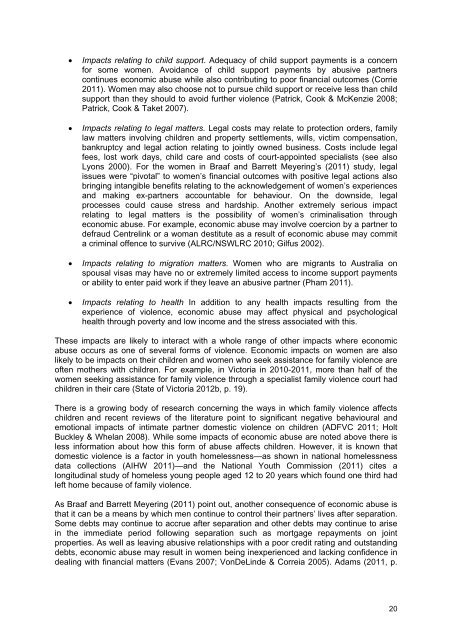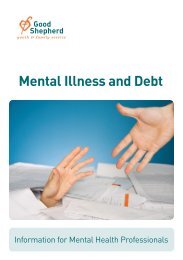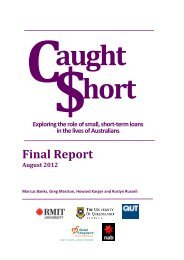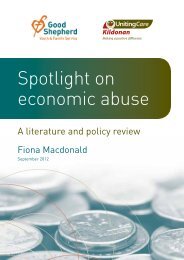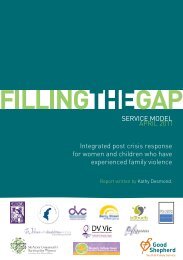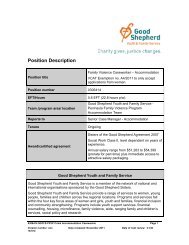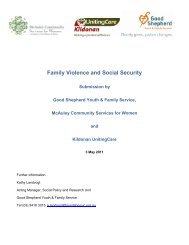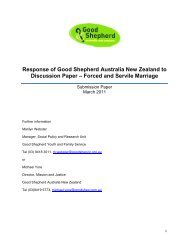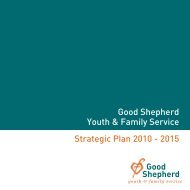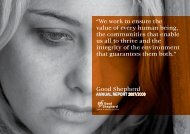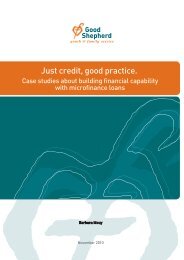Spotlight on economic abuse - Good Shepherd Youth & Family ...
Spotlight on economic abuse - Good Shepherd Youth & Family ...
Spotlight on economic abuse - Good Shepherd Youth & Family ...
You also want an ePaper? Increase the reach of your titles
YUMPU automatically turns print PDFs into web optimized ePapers that Google loves.
Impacts relating to child support. Adequacy of child support payments is a c<strong>on</strong>cern<br />
for some women. Avoidance of child support payments by abusive partners<br />
c<strong>on</strong>tinues ec<strong>on</strong>omic <strong>abuse</strong> while also c<strong>on</strong>tributing to poor financial outcomes (Corrie<br />
2011). Women may also choose not to pursue child support or receive less than child<br />
support than they should to avoid further violence (Patrick, Cook & McKenzie 2008;<br />
Patrick, Cook & Taket 2007).<br />
Impacts relating to legal matters. Legal costs may relate to protecti<strong>on</strong> orders, family<br />
law matters involving children and property settlements, wills, victim compensati<strong>on</strong>,<br />
bankruptcy and legal acti<strong>on</strong> relating to jointly owned business. Costs include legal<br />
fees, lost work days, child care and costs of court-appointed specialists (see also<br />
Ly<strong>on</strong>s 2000). For the women in Braaf and Barrett Meyering’s (2011) study, legal<br />
issues were “pivotal” to women’s financial outcomes with positive legal acti<strong>on</strong>s also<br />
bringing intangible benefits relating to the acknowledgement of women’s experiences<br />
and making ex-partners accountable for behaviour. On the downside, legal<br />
processes could cause stress and hardship. Another extremely serious impact<br />
relating to legal matters is the possibility of women’s criminalisati<strong>on</strong> through<br />
ec<strong>on</strong>omic <strong>abuse</strong>. For example, ec<strong>on</strong>omic <strong>abuse</strong> may involve coerci<strong>on</strong> by a partner to<br />
defraud Centrelink or a woman destitute as a result of ec<strong>on</strong>omic <strong>abuse</strong> may commit<br />
a criminal offence to survive (ALRC/NSWLRC 2010; Gilfus 2002).<br />
Impacts relating to migrati<strong>on</strong> matters. Women who are migrants to Australia <strong>on</strong><br />
spousal visas may have no or extremely limited access to income support payments<br />
or ability to enter paid work if they leave an abusive partner (Pham 2011).<br />
Impacts relating to health In additi<strong>on</strong> to any health impacts resulting from the<br />
experience of violence, ec<strong>on</strong>omic <strong>abuse</strong> may affect physical and psychological<br />
health through poverty and low income and the stress associated with this.<br />
These impacts are likely to interact with a whole range of other impacts where ec<strong>on</strong>omic<br />
<strong>abuse</strong> occurs as <strong>on</strong>e of several forms of violence. Ec<strong>on</strong>omic impacts <strong>on</strong> women are also<br />
likely to be impacts <strong>on</strong> their children and women who seek assistance for family violence are<br />
often mothers with children. For example, in Victoria in 2010-2011, more than half of the<br />
women seeking assistance for family violence through a specialist family violence court had<br />
children in their care (State of Victoria 2012b, p. 19).<br />
There is a growing body of research c<strong>on</strong>cerning the ways in which family violence affects<br />
children and recent reviews of the literature point to significant negative behavioural and<br />
emoti<strong>on</strong>al impacts of intimate partner domestic violence <strong>on</strong> children (ADFVC 2011; Holt<br />
Buckley & Whelan 2008). While some impacts of ec<strong>on</strong>omic <strong>abuse</strong> are noted above there is<br />
less informati<strong>on</strong> about how this form of <strong>abuse</strong> affects children. However, it is known that<br />
domestic violence is a factor in youth homelessness—as shown in nati<strong>on</strong>al homelessness<br />
data collecti<strong>on</strong>s (AIHW 2011)—and the Nati<strong>on</strong>al <strong>Youth</strong> Commissi<strong>on</strong> (2011) cites a<br />
l<strong>on</strong>gitudinal study of homeless young people aged 12 to 20 years which found <strong>on</strong>e third had<br />
left home because of family violence.<br />
As Braaf and Barrett Meyering (2011) point out, another c<strong>on</strong>sequence of ec<strong>on</strong>omic <strong>abuse</strong> is<br />
that it can be a means by which men c<strong>on</strong>tinue to c<strong>on</strong>trol their partners’ lives after separati<strong>on</strong>.<br />
Some debts may c<strong>on</strong>tinue to accrue after separati<strong>on</strong> and other debts may c<strong>on</strong>tinue to arise<br />
in the immediate period following separati<strong>on</strong> such as mortgage repayments <strong>on</strong> joint<br />
properties. As well as leaving abusive relati<strong>on</strong>ships with a poor credit rating and outstanding<br />
debts, ec<strong>on</strong>omic <strong>abuse</strong> may result in women being inexperienced and lacking c<strong>on</strong>fidence in<br />
dealing with financial matters (Evans 2007; V<strong>on</strong>DeLinde & Correia 2005). Adams (2011, p.<br />
20


